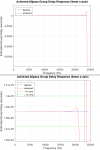CBT's made for a fun DIY project. Used 24 of the same 3.5" drivers, on an 11 ft radius arc. Simple beginner's CBT/line array project.
Simple other than figuring out how to make a router circle-cutting jig to handle the big arc! lol
I grouped the drivers into six sets of 4 drivers each, for the level shading a CBT requires. Wish I could have done all individually, but ugh..that's a lot of wiring and amp/processing channels.
Two sonic properties of the CBT's really stood out:
First how room placement neutral they were. Just stayed even...nice. And second, how the height of the apparent image center off the floor maybe 3 ft up, didn't change much with distance. I could change from seated and walk up close and the image stayed in the same spot the entire time.
I made baffle that held the 24 drivers removable so I could also mount it on a straight-line box, ala the Murphy corner array style.
It was fun to try to mimic the CBT with delays and level shading. Could get reasonably close, but no cigar. Maybe hurt a little by lack of discrete amplification & processing for each of the 24 drivers. But groups of 4 did at least work pretty well.
Along with trying to mimic the CBT, it was fun to play with the straight line outdoors, moving the apparent acoustic center up and down the line, via delay and/or levels.
Stacked on a sub, it was cool to hear how sound could be made to seem to come from near the top or the line, well over the tops of the heads. Could make for nice small and pleasant backyard party system.




Simple other than figuring out how to make a router circle-cutting jig to handle the big arc! lol
I grouped the drivers into six sets of 4 drivers each, for the level shading a CBT requires. Wish I could have done all individually, but ugh..that's a lot of wiring and amp/processing channels.
Two sonic properties of the CBT's really stood out:
First how room placement neutral they were. Just stayed even...nice. And second, how the height of the apparent image center off the floor maybe 3 ft up, didn't change much with distance. I could change from seated and walk up close and the image stayed in the same spot the entire time.
I made baffle that held the 24 drivers removable so I could also mount it on a straight-line box, ala the Murphy corner array style.
It was fun to try to mimic the CBT with delays and level shading. Could get reasonably close, but no cigar. Maybe hurt a little by lack of discrete amplification & processing for each of the 24 drivers. But groups of 4 did at least work pretty well.
Along with trying to mimic the CBT, it was fun to play with the straight line outdoors, moving the apparent acoustic center up and down the line, via delay and/or levels.
Stacked on a sub, it was cool to hear how sound could be made to seem to come from near the top or the line, well over the tops of the heads. Could make for nice small and pleasant backyard party system.
